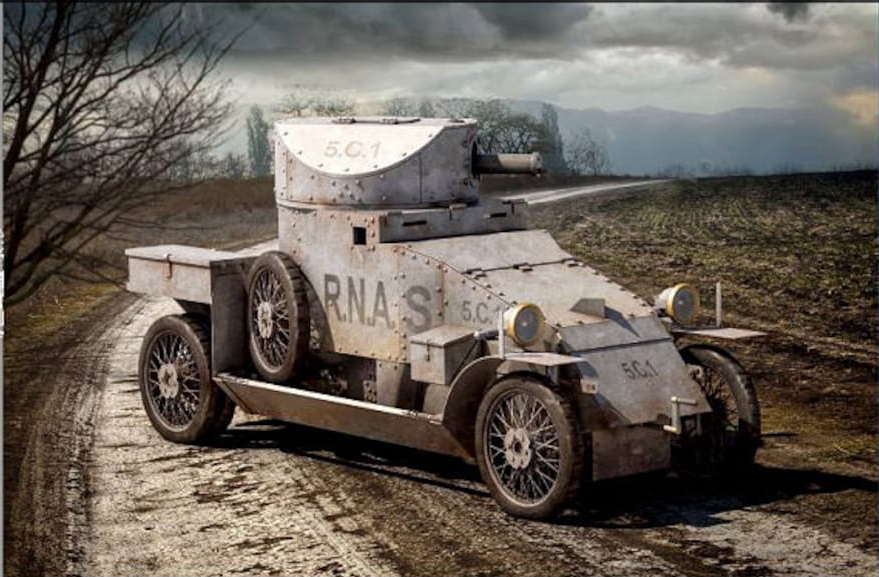
After the Rolls-Royce armoured car, the Armoured Car, Lanchester (Admiralty Turreted Pattern) was the most numerous in service with the Royal Naval Air Service (RNAS) armoured car squadrons that had sprung up by the end of 19 14, Originally these armoured cars were supposed to provide support for the air bases and to retrieve downed airmen, but it was not long before they were used in more offensive roles. BY the beginning of 1915 they were being organised into formal armoured car squadrons as part of a larger Royal Naval Armoured Car Divisions.
In appearance the Lanchester armoured car was very similar in layout to the Rolls-Royce and also had a turret with sloping sides, However, the Lanchester had sloping armour over the front of the bonnet in place of the more angular bonnet of the Rolls-Royce. It was originally a civilian touring car but by the time the Admiralty designers had been at work little of the original bodywork remained. However, the engine was retained for not only did it provide a useful 60 hp (44.7 kW) but it had many advanced design features for its day, along with a very advanced epicyclic gearbox,
When the Royal Navy armoured cars were handed over to the army in August 1915 the latter decided that the collection of designs it received was too varied for logistic and operational comfort. It thus decided to standardize the Rolls-Royce design, and the Lanchesters were put to one side. They did not remain neglected for long for in October 1915 they were gathered together in England. The following year they were organized as No, I Squadron of the Royal Naval Armoured Car Division and sent to Russia. Once there they took part in no end of campaigns about which little has been recorded. For much of the time the Lanchesters had to travel on their own wheels across country where few roads existed, and were used in Persia, Romania and Galicia, operating in climates that varied from desert heat to near-Arctic conditions. But they kept going. For much of their operational life the Lanchesters were used in a manner that anticipated what was later to become the norm in armoured warfare. They acted as the spearhead of large motorised columns carrying troops on armoured lorries and personnel trucks that ranged far and wide over the wastes of southern Russia and the Iraq deserts. They acted as scouts, fire-support vehicles and general raiders, roles in which the Lanchesters proved reliable and fast,
The Lanchester remained with the Russians until the final failure of the Brusilov Offensive in mid-1917. There after Russian sank into the throes of internal disruption and revolution, and there was no part the Lanchester squadron could play in such internal conflicts. Thus they were shipped back to the United Kingdom with well over 53,000 miles added to their speedometer clocks.
Specifications
Mass 4.8 long tons (4.9 t)
Length 16 ft (4.9 m)
Width 6 ft 4 in (1.93 m)
Height 7 ft 6 in (2.29 m)
Crew 4
Armour 0.31 in (7.9 mm)
Main armament .303 in (7.7 mm) Vickers machine gun
Engine 6-cylinder Lanchester petrol 60 hp (45 kW)
Drive Wheeled 4×2
Transmission Pre-selective epicyclic gearbox
Suspension Cantilever springs
Operational range 180 mi (290 km)
Maximum speed 50 mph (80 km/h)